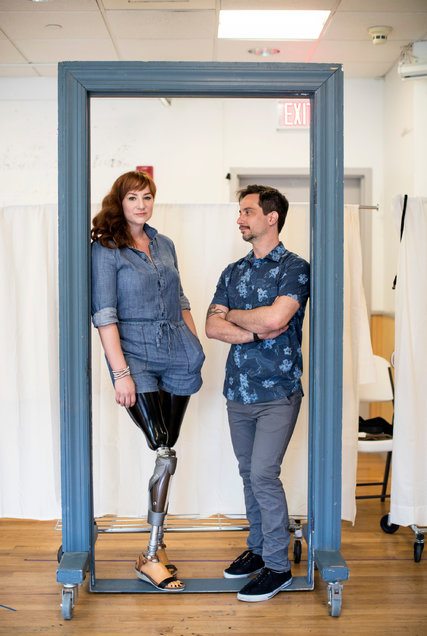Read the NY Times article featuring Cost Of Living actors Katy Sullivan and Gregg Mozgala!

Actors Katy Sullivan and Gregg Mozgala. Photo by Nathan Brooks for The New York Times.
Actors With Disabilities Are Ready, Willing and Able to Take More Roles
John, a Ph.D. candidate in political science, has cerebral palsy. So does Gregg Mozgala, who portrays him in this Williamstown Theater Festival production running through July 10. Ani, another character, is played by Katy Sullivan, a professional actress who is a Paralympic medalist. Their casting — in a high-profile production that will end up at the Manhattan Theater Club — is a visible sign of change when it comes to performers with disabilities, who rarely appear onstage, even as stories of disability offer rich and, yes, prize-generating material for actors.
Ms. Sullivan, who was born without lower legs, doesn’t believe that able-bodied performers should be prevented from playing the disabled. She sees acting as “putting on someone else’s soul, putting on someone else’s life experiences and trying to be truthful about them, whether you’re disabled or not.” Still, she noted, “Using performers with disabilities brings a layer of authenticity that you don’t have to go searching for.”
The Deaf West Theater production of “Spring Awakening,” which earned enthusiastic reviews when it played on Broadway last season, may have excited new interest in casting actors with disabilities. The recently announced Broadway revival of “The Glass Menagerie” will co-star Madison Ferris, an actress who uses a wheelchair, as Laura Wingfield. “I Was Most Alive With You,” which just ran at the Huntington Theater Company in Boston, was written by Craig Lucas expressly for the deaf actor Russell Harvard.
This is not exactly business as usual. The past several Broadway seasons have included shows like “The Cripple of Inishmaan,” “Richard III,” “Of Mice and Men,” “The Elephant Man,” “Side Show” and “The Curious Incident of the Dog in the Night-Time.” In these plays and musicals, able-bodied actors played characters with physical or cognitive disabilities. Other recent “Glass Menagerie” revivals have cast actresses who can leave Laura’s limp at the stage door. (Representatives for the coming production declined to comment on its casting.)
Recent conversations around this issue, in film and television as well as in theater, have become more contentious, with comparisons often drawn to traditions of blackface. As the journalist Frances Ryan wrote in an opinion piece for The Guardian last year, “Perhaps it is time to think before we next applaud ‘cripping up.’ Disabled people’s lives are more than something for non-disabled actors to play at.”
Or, as Howard Sherman, the interim director of the Alliance for Inclusion in the Arts, put it: “Playing someone with a disability should not be considered a talent or a skill for nondisabled actors. It should be considered taking a job away from someone with the unique life experiences to portray that role.”
The language around these issues is also fraught. If “disabled” remains the standard term, some artists and activists resist its connotation of impairment. (Many who are deaf would argue against deafness being construed as a disability, for example.) The term “differently abled” is a common alternative, though some prefer more individual vocabulary.
Ali Stroker, the “Spring Awakening” performer who was said to be the first actress in a wheelchair to appear on Broadway, occasionally heard discouraging words.
Ms. Stroker, who said she was also the first actor in a wheelchair to graduate from New York University’s rigorous theater training program, recalled a casting director telling her, “This is going to be very hard for you.”
“Perfect,” Ms. Stroker said. “My life has been hard. I don’t like easy things.”
She added: “My experience of having a disability my entire life was perfect training for this industry. I’m used to hearing no. I’m used to being creative when someone has closed a door.”
But how many doors are open even now? With the exception of theaters like Deaf West, Theater Breaking Through Barriers and the Apothetae (founded by Mr. Mozgala) — created in part to provide opportunities for artists with disabilities — and companies like the Oregon Shakespeare Festival, which has committed to integrating disabled actors, most able-bodied roles go to able-bodied actors.
And many disabled roles still go to able-bodied actors, too. Sometimes this is necessary, as in roles that show gradual deterioration or unexpected recovery, or roles that call for a rare physical type, like the conjoined twins of “Side Show.” Sometimes it isn’t.
There has been controversy, for example, regarding the casting of Christopher in “Curious Incident,” a young man whose behavior places him on the autism spectrum. Some have used social media to pressure the producers to make auditions more accessible and welcoming to autistic actors. As the actor Mickey Rowe wrote in an email, “All too often we learn about autism from non-autistic people instead of going straight to the source.”
Mr. Harvard, a deaf actor often cast in deaf roles, appears the exception. In addition to his theater work, which included a starring part in Nina Raine’s widely produced “Tribes,” he has significant film credits and was prominently featured in the first season of the “Fargo” TV series. But even he has had difficulty finding parts.
“How many roles are there out there that incorporate ASL?” he wrote in an email message. “The opportunities are rare.” The idea that hearing actors might be cast in deaf roles affronts him. “If someone were to make a movie about my life and cast a hearing actor to play me …” He couldn’t complete the sentence.
When the roles are available, producers, directors and casting directors may have to search harder for disabled actors. Mandy Greenfield, the artistic director at Williamstown, agreed that it took extra work to assemble a pool of possible stars for “Cost of Living.”
Ms. Majok’s script stipulates that John and Ani be played by disabled performers; Mr. Mozgala, who helped Ms. Majok develop the play (the description of cerebral palsy as an internal fistfight is his configuration), was a sure thing. But Williamstown had to do a rigorous search to find Ani.
“Our intense process yielded absolutely magical results,” Ms. Greenfield said. (Manhattan Theater Club has yet to confirm casting for the spring production, but producers said they would honor Ms. Majok’s stipulation.)
Unlike her character, Ms. Sullivan is not paralyzed but rather runs record-setting sprints on prosthetic limbs. Conveying paralysis requires acting; maneuvering without prosthetics contributed to her understanding of the character.
“It helps me get to a place of vulnerability, because that’s not how I live my life,” she said. “I tend to wear my prosthetics wherever I go, and they make me feel a certain confidence. Taking those off, in some ways, is like being naked.”
It remains to be seen whether the recent casting of disabled actors marks a temporary uptick or a more lasting trend. Though D. J. Kurs, the artistic director of Deaf West, believes that “Spring Awakening” showed audiences the evocative language and gestures of deaf actors, “My cynical side, however, reminds me that the collective memory is short,” he wrote by email.
Mr. Mozgala hopes that artists themselves will create opportunities. His company, the Apothetae, has commissioned playwrights with this aim. “My community, and the history of disabled people, is fascinating,” he said. “Me just walking across the street — there’s something dramatic going on.”
Correction: July 1, 2016
An article on Thursday about the use of actors with disabilities to portray disabled characters referred incorrectly to the character played by Katy Sullivan, who was born without lower legs, in “Cost of Living” at the Williamstown Theater Festival. The character, Ani, is paralyzed; it is not the case she is not paralyzed.




